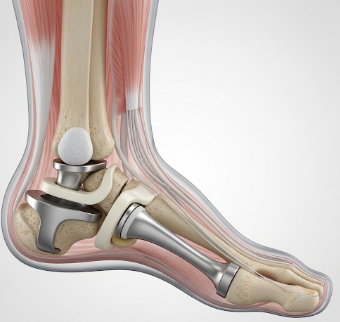Overview
Total ankle replacement (TAR), also called ankle arthroplasty, is a surgical procedure where a damaged ankle joint is replaced with an artificial implant. This treatment is typically recommended for patients with severe ankle arthritis, chronic pain, or limited mobility when other conservative therapies (like medications, physiotherapy, or injections) no longer provide relief.
In Korea, advanced orthopedic and joint replacement centers specialize in TAR using state-of-the-art prosthetic implants and minimally invasive surgical techniques. Patients benefit from shorter recovery times, reduced pain, and restoration of joint function.
What is Total Ankle Replacement?
Total ankle replacement is the surgical removal of a diseased ankle joint and its replacement with metal and plastic prosthetic components that mimic the natural joint’s motion.
Indications include:
- ✦ Severe osteoarthritis of the ankle.
- ➤ Rheumatoid arthritis causing joint destruction.
- ✦ Post-traumatic arthritis after fractures or injuries.
- ➤ Severe pain and stiffness that limits daily activities.
Unlike ankle fusion (arthrodesis), which eliminates joint motion, TAR preserves movement and allows for more natural walking.
What are the Benefits?
Benefits of total ankle replacement include:
✅ Relief from chronic ankle pain.
➤ Improved mobility and function compared to fusion.
✦ Preservation of joint motion, allowing more natural walking.
➤ Lower risk of arthritis developing in nearby joints compared to fusion.
✅ Enhanced quality of life and ability to return to daily activities.
✦ Safe, effective procedure in specialized Korean orthopedic centers.
Procedure Details
1) How should I prepare for Total Ankle Replacement?
Preparation steps include:
- ✦ Medical evaluation: review of overall health, ankle imaging (X-rays, CT, MRI), and blood tests.
- ➤ Medication management: adjusting blood thinners or other medications.
- ✦ Physical preparation: strengthening surrounding muscles with physiotherapy.
- ➤ Pre-surgery counseling: discussion of risks, benefits, and implant options.
- ✦ Fasting: required if undergoing general or spinal anesthesia.
- ➤ Lifestyle modifications: quitting smoking, maintaining healthy weight for better recovery.
2) What happens during the procedure Total Ankle Replacement?
The surgery is usually performed under general or spinal anesthesia and lasts 2–3 hours:
➤ Step 1: An incision is made at the front or side of the ankle.
✦ Step 2: Damaged cartilage and bone are carefully removed.
➤ Step 3: Prosthetic components (metal + polyethylene) are inserted into the tibia and talus bones.
✦ Step 4: The artificial joint is aligned to ensure smooth movement.
➤ Step 5: The incision is closed, and a sterile dressing is applied.
✦ Step 6: The ankle is stabilized with a splint or cast.
In Korea, advanced surgical navigation and customized implants are often used for precision and better long-term outcomes.
3) What happens after Total Ankle Replacement?
After surgery, recovery involves:
- ✦ Hospital stay: typically 3–5 days.
- ➤ Pain management: with medications and ice therapy.
- ✦ Immobilization: ankle kept in a splint/cast initially.
- ➤ Physical therapy: gradual rehabilitation begins within days to weeks.
- ✦ Weight-bearing: limited for 4–6 weeks, followed by gradual walking with crutches or walker.
- ➤ Full recovery: may take 3–6 months, depending on individual healing.
Risks / Benefits
Potential Risks:
- ✦ Infection around implant.
- ➤ Blood clots (deep vein thrombosis).
- ✦ Implant loosening or wear over time.
- ➤ Nerve or blood vessel injury.
- ✦ Joint stiffness or instability.
- ➤ Need for revision surgery in the future.
Benefits:
- ✅ Effective relief of ankle arthritis pain.
- ✅ Restores ankle mobility unlike fusion.
- ✅ Improves walking ability and quality of life.
- ✅ Advanced implants in Korea ensure long-lasting durability.
- ✅ Safer, minimally invasive techniques available in top centers.
Recovery and Outlook
Recovery after TAR requires patience and adherence to physiotherapy:
- ➤ Short-term: swelling, mild pain, and mobility limitations are common for 4–6 weeks.
- ✦ Medium-term: most patients walk comfortably with improved function by 3 months.
- ➤ Long-term: implants last 10–20 years with proper care, though younger patients may eventually need revision surgery.
- ✦ With Korea’s advanced orthopedic care, patients achieve excellent long-term outcomes and mobility restoration.
When To Call the Doctor
Contact your doctor immediately if you notice:
⚠ Persistent fever or signs of infection at incision site.
⚠ Excessive swelling, redness, or discharge.
⚠ Severe pain not relieved by medication.
⚠ Difficulty moving toes or foot.
⚠ Chest pain or shortness of breath (possible blood clot).
Best Korea Option / Process
Korea is an international hub for joint replacement surgeries, including TAR, offering:
- ✦ Experienced orthopedic surgeons with global training.
- ➤ Cutting-edge prosthetic implants tailored for durability and function.
- ✦ Advanced imaging and navigation systems for precise implant placement.
- ➤ Multidisciplinary rehabilitation programs for faster recovery.
- ✦ Affordable compared to Western countries, with world-class outcomes.
- ➤ Specialized hospitals catering to international patients with comprehensive care packages.
Highlights of Total Ankle Replacement in Korea
- ✅ Restores ankle mobility and function.
- ➤ Relieves pain from severe arthritis or trauma.
- ✦ Preserves motion compared to ankle fusion.
- ➤ Advanced surgical techniques and implants in Korea.
- ✅ High success rate and faster recovery with specialized rehabilitation.













